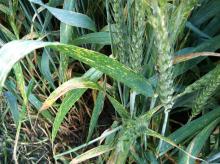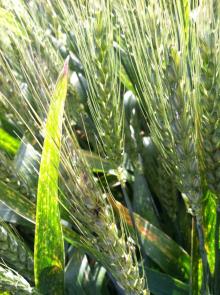See:
Fungicide Effectiveness as Seed Treatments for Cereal Diseases
Cause A fungus, Puccinia striiformis (syn. P. glumarum), which may oversummer on volunteer or early fall-seeded wheat and certain wild grasses (Aegilops, Agropyron, Elymus, and wild Hordeum spp.), and sometimes cultivated barley. The fungus overwinters as mycelium in leaf tissues, surviving down to at least 23°F, but spores can blow in from distant infections. Cool summers, mild winters, and long, cool, wet springs favor the fungus. Historically, 50°F to 64°F temperatures with intermittent rains or dews was optimal for disease development but new races of stripe rust appear to be adapted to warmer temperatures and are aggressively attacking hard red wheats in the Midwestern United States and overcoming high-temperature adult-plant resistance in winter wheats throughout the Pacific Northwest.
Symptoms Citron-yellow uredinia (spore masses) appear in long stripes on leaves and, rarely, on stems and heads. As the crop matures, black spores (telia) are produced in stripes, which are covered by the leaf epidermis.
Cultural control
- Most commercial winter wheat varieties had good to excellent resistance until 2004, when a new race appeared. Current ratings are available in extension and crop improvement association variety selection literature.
Chemical control Foliar applications can be made if disease is present and conditions are expected to remain favorable. Field scouting aids in detecting stripe rust early in the epidemic, while the disease still can be managed through fungicide applications. Once the crop is in the grain-filling stage, fungicide benefits are unlikely.
- Demethylation-inhibiting (DMI) fungicides (Group 3) are labeled for use.
- Alto 100SL at 3.0 to 5.5 fl oz/A applied between Feekes Stage 8 and 10.5.1 Preharvest interval is 21 days forage and hay; 30 for grain and straw. 12-hr reentry.
- Bumper 41.8 EC at 4 fl oz/A. May be applied until Feekes growth stage 10.5. Do not treat within 30 days of harvest for forage or hay. 12-hr reentry.
- Tebuzol 3.6F at 4 fl oz/A at flag-leaf emergence up to the end of flowering. Do not apply within 30 days of harvest. 12-hr reentry.
- Tilt at 4 oz/A at flag-leaf emergence (Feekes stage 8) but no later than Feekes 10.5. Do not apply within 7 days of harvest for forage or hay. 12-hr reentry.
- Topguard at 10 to 14 fl oz/A on 7-day intervals. Preharvest interval is 0 days for forage, 15 days for hay, and 30 days for grain. 12-hr reentry.
- JMS Stylet-Oil at 1 to 2 pints/A is labeled for use in Oregon (SLN OR-120011, SLN OR-120012). Up to three (3) applications can be made starting when the first node of the stem is visible (Feekes 6) through the end of flowering (Feekes 10.5). Do not spray if foliage is wet or if the temperature is below 32°F, above 90°F or when plants are under heat or moisture stress. 4-hr reentry. O
- Strobilurin fungicides (Group 11) are labeled for use. Do not make more than one (1) application of a Group 11 fungicide before alternating to a labeled fungicide with a different mode of action.
- Aftershock at 2 to 4 fl oz/A on 14- to 21- day intervals up to late head emergence (Feekes 10.5). Make no more than one (1) application prior to harvest of wheat forage. Do not apply within 7 days of harvest for forage and hay; 40 days of harvest for grain and straw. 12-hr reentry.
- Headline at 6 to 9 fl oz/A no later than the end of flowering (Feekes 10.5). Preharvest interval is 14 days for hay and forage. 12-hr reentry.
- Quadris Flowable at 4 to 12 fl oz/A up to late head emergence (Feekes 10.5). Do not apply within 7 days of harvest for forage and hay and 14 days of grazing. 4-hr reentry.
- Succinate dehydrogenase inhibitors (SDHI) fungicides (Group 7) are labeled for use and include the following fungicide as well as other formulations. SDHI fungicides should always be mixed with a DMI fungicide to avoid selection for fungicide resistance.
- Vertisan at 10 to 24 fl oz/A on 7- to 14-day intervals through flowering (Feekes 10.5.1). Do not make more than two (2) sequential applications before alternating to a labeled fungicide with a different mode of action (non-Group 7). Preharvest interval is 0 days for forage and hay. 12-hr reentry.
Note: Premixed fungicides are available for use. Do not make more than one (1) application of any Group 11 fungicide before alternating to a labeled fungicide with a different mode of action.
- Dexter Max (Group M3 + 11) at 2.1 lb/A on 7- to 10-day intervals. Applications may be applied up to Feekes growth stage 10.5. Preharvest interval for hay is Feekes growth stage 10.5, but no less than 26 days; grain and straw is 45 days. 24-hr reentry.
- Dexter Xcel (Group M3 + 11 +3) at 48 fl oz/A. The single application may be applied up to Feekes growth stage 10.54. Preharvest interval is 30 days. 24-hr reentry.
- Miravis Ace (Group 3 + 7) at 13.7 fl oz/A. Apply between Feekes 10.3 and 10.5.4. Harvest interval is 7 days for forage and hay. 12-hr reentry.
- Priaxor (Group 7 + 11) at 4 to 8 oz/A immediately after flag leaf emergence but no later than the beginning of flowering (Feekes 10.5). Preharvest interval is 7 days for forage and chopped feed. 12-hr reentry.
- Quilt Xcel (Group 3 + 11) at 10.5 to 14 fl oz/A when the flag leaf is 50% to fully emerged. Applications may be made no closer than a 14-day interval and may be applied up to Feekes growth stage 10.5. Do not make more than two (2) applications per season. Preharvest interval is 7 days for forage and hay. 12-hr reentry.
- Stratego (Group 3 + 11) at 10 fl oz/A. Do not apply after flag-leaf emergence (Feekes stage 8). Do not make more than two (2) applications per season. Do not apply within 35 days of harvest. See label for grazing, forage, and hay restrictions. 12-hr reentry.
- Trivapro (Group 3 + 7 + 11) at 9.4 to 13.7 fl oz/A beginning when the flag leaf is 50% to fully emerged, up through full head emergence. Do not make more than two (2) sequential applications of Trivapro or other Group 7 or Group 11 fungicides. Preharvest interval is 7 days for forage and hay, 14 days for grain. 12-hr reentry.



